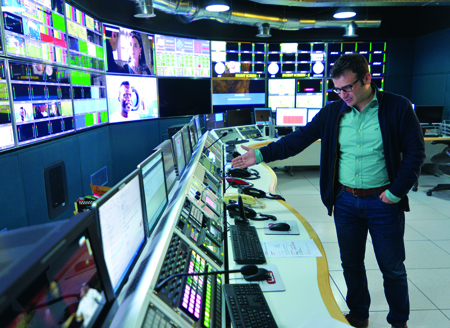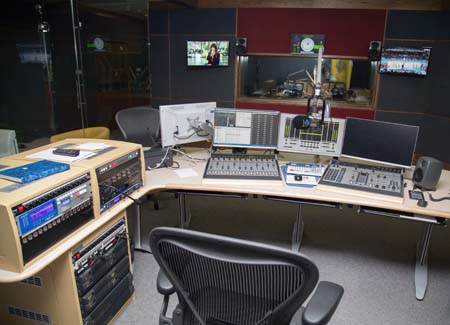Dubai Channels Network recently unveiled its Master Control Room refurbished with state-of-the-art equipment and enhanced capabilities. Located at the DMI headquarters in Oud Metha, Dubai, the new facility has been effectively built from scratch, replacing most of the old equipment with the latest upgraded tools.
 Dubai Channels Network has recently revamped its MCR with state-of-the-art equipment that offers expanded capabilities and greater control. Vibhuti Arora goes on site for more details
Dubai Channels Network has recently revamped its MCR with state-of-the-art equipment that offers expanded capabilities and greater control. Vibhuti Arora goes on site for more details
Dubai Channels Network recently unveiled its Master Control Room refurbished with state-of-the-art equipment and enhanced capabilities. Located at the DMI headquarters in Oud Metha, Dubai, the new facility has been effectively built from scratch, replacing most of the old equipment with the latest upgraded tools. It features new antennas and IRDs as well as a new L-band/RF matrix from ETL, in addition to new routers, multiviewers and monitors.
The switch from the old to the new was seamless with zero downtime, as the new machines were deployed while the old systems were still operational. Saleh Lootah, Head of TV & Radio Engineering at Dubai Media Inc., says the MCR revamp is the first step towards speeding up DMIs response time to issues.
We are now better equipped and can be more proactive to any kind of issues affecting the broadcast of our channels. Our MCR has enhanced capability and will have more responsibility as we continue to upgrade our systems.
The entire DMI bouquet, comprising 13 channels, is monitored in the MCR, explains Lootah. This is the first point of contact where signals via microwave, fibre and satellite sources come into DMI, are checked for quality and routed to the studios or the transmission room. The output from the transmission room is routed back to the MCR for further checks and then sent to Samacom for broadcast.
We receive multiple feeds from several sources here. For instance, Abu Dhabi TV, Sharjah TV and Dubai Media Office are connected to the MCR through fibre. The Al Marmoum camel racing track is also being monitored here through a fibre connection. Then there are a number of satellite as well as studio feeds coming into the MCR to be sent to transmission, deep archive or on air, he adds.
The monitor wall has been built from scratch in the new facility. The previous facility had six Sharp monitors, now replaced by 20 new Samsung monitors. Having centralised the operations also enables the broadcaster to monitor its FM channels from the same room. The old Evertz multiviewers have been replaced by the latest ones from the same vendor.
For me personally, any major event, be it New Years Eve, the horse races or any big events in Dubai, I operate from this room to monitor them. It gives us better visibility and improved communication. We can keep close tabs on emergencies should they arise, and are better equipped to handle them, says Lootah.
Afzal Lakdawala, Head of Technology Planning and Projects at DMI, says that with the new MCR, monitoring and control have been made easy via a new user interface and control panels on the operators desk that are capable of monitoring an increased number of ingest feeds. This also enables the monitoring of several incoming and outgoing feeds, off-air as well as to the teleport, across 20 ultra-high definition screens. The routing of RF signals from any antenna to any IRD is simpler now.
The motorised antenna, installed as part of the project, cover a wide range of satellites thereby ensuring the operators easily tune into the desired frequencies as and when required.
A big advantage from the previous system is that the number of incoming feeds from external sources for monitoring and routing requirements has significantly increased. This offers the MCR operator more flexibility in choosing from different sources right from his desk. We have also factored in the future expansion and a lot of emphasis has been laid on installing the technology, which is future proof, Lakdawala explains.
Omar Alzoubi, Senior Manager Engineering Systems at DMI, adds that the increased capability of the new MCR means it covers more sources to be viewed at one time. The router is hybrid,which means it can be run on the existing SDI infrastructure in the facility as well as on IP technology in the future.
DMI is on the road to unifying and centralising its file-based systems and the related workflow by deploying operational flexibility, scalability and the most sophisticated trends, Alzoubi says.
The L-band /RF matrix router, baseband multiviewer and router, A/V QC, signal monitoring and measurement equipment deployed in this project future-proofs the operations of the MCR.
The newly installed Ericsson and Ateme IRDs adhere to the latest industry standard codec HEVC (H.265) thereby making the systems future-ready for production, contibution and distribution.
Alzoubi further adds that the HEVC codec reduces bandwidth requirement by 40-50% compared to the previously used H.264 or MPEG-4 codec, thereby reducing cost. In comparison, HEVC offers about double the data compression ratio at the same level of video quality, or substantially improved video quality at the same bit rate and paves the way to support UHDTV and higher resolutions for enhanced user experience.
While selecting equipment, we have also considered introducing hybrid infrastructure which was compatible with both baseband and IP, says Alzoubi.
The MCR upgrade is the answer to the broadcasters growing demand for more capacity and better connectivity. The upgraded facility can handle up to 30 concurrent satellite feeds and 25 feeds via fibre.
The MCR was last upgraded in 2005, which fulfilled our requirement at that time. However, now with our HD channels and expanded network, we need a more robust facility, hence the recent upgrade this year. The previous equipment had several limitations, which posed a challenge. Some of our new equipment is from the same vendors, but we have the latest models now, which are more suited to our needs in the present scenario, Yusuf Al Dahel, MCR Manager at DMI, explains.
The analogue fibre interface has been replaced with a digital one, and the entire network is now capable of handling HD.
We worked with Etisalat to upgrade the fibre infrastructure and the interface at the DMI headquarters, which has given us better coverage and increased capacity. We can launch more channels and handle many more feeds from various sources now.
The new system is tapeless and everything that comes into the MCR is recorded. The quality check for incoming content is conducted on the side. QC is also conducted on off-air content. The content is then sent for editing or archiving. The MCR can record 20 channels at the same time, which means 20 inputs and feeds can be recorded simultaneously. Monitoring of all incoming and outgoing signals takes place here.
Commenting on the smooth transition from the old system to the new one, MCR Project Manager Mohammad Rajha says: We achieved the quality and appropriate development of MCR equipment as per DMI’s requirements. The migration to the new system in the same premises involved seamless coordination between various departments such as engineering, operations and the systems integrator for the project, Tek Signals.
The LNB router matrix is now 32 by 32 the previous one was 16 by 16. The motorised dish downloads feeds from new satellites directly. They only had fixed dishes earlier, which are still used each dedicated to a satellite but the motorised one is remote controlled to access a particular satellite.
We had to use Samacom to download feeds for us previously, which was an added cost, says Yamen Ali Laila, MCR Engineer.
The ASI router is very useful in receiving multiservice signals, according to Laila. In the previous system, all IRDs received only dedicated feeds from a particular source. The ASI routers lend more flexibility and the IRDs can handle multiservice feeds from multiple sources now. The latest NS3 demodulator receives DVB and DVB-S2, which was not there previously.
The upgraded MCR has been future-proofed and capable of adding more channels quickly.












































































